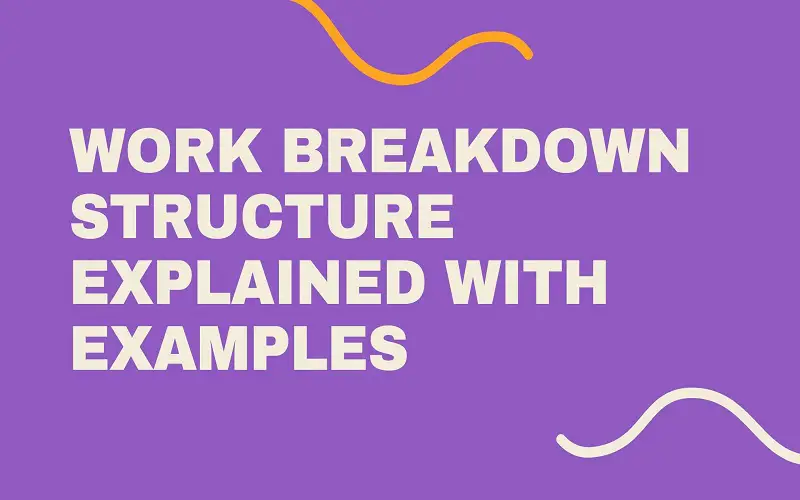You must have heard of the work breakdown structure. However, if you are just getting started with project management, this article should serve as a good starting point. Several essential instruments are needed to get the project off the ground, and the WBS, fully known as the Work Breakdown Structure, is one of them.
In the discussions to follow, we will look at the fundamentals of the work breakdown structure, how you can develop one, some of the best practices when creating a work breakdown structure, an example and any other information that you ought to know regarding the work breakdown structure.
We hope that this article will add to your project management knowledge by understanding some of its fundamentals.
What is The Work Breakdown Structure?
We cannot sustain a discussion around WBS without defining it. It is a definition of everything that the project must accomplish, usually organized into several levels and displayed graphically.
A better and more detailed explanation is that it is a deliverable-oriented decomposition of all the work that the project team must do to ensure that the project objectives are met and the required deliverables created. These are normally arranged hierarchically.
The Work Breakdown Structure, therefore, defines the ‘what’ of the project. These are usually captured in a single and easy to understand chart, which decomposes technical and relatively complex activities into smaller and easy to manage parts.
It has its characteristics that you need to know. Remember, these are distinct features that will help you identify it, given that not every project breakdown is a work breakdown structure. Let’s take a look.

Characteristics of the Work Breakdown Structure
- It is hierarchical
The Work Breakdown Structure is hierarchical. There are parent and child levels that are presented in a strict hierarchical relationship. This is important since it is only by executing these child levels will the parent element be successful.
- Mutual exclusivity
Like we mentioned, the WBS has different levels. All elements at a given level must be mutually exclusive, which serves to prevent miscommunication and reduce instances of duplicate work.
- It is focused on the outcome.
Like the name suggests, the WBS is outcome-focused. It is focused on the deliverables, which are normally the result of the work and not the activities needed to achieve these deliverables. This explains why the elements are described as nouns and not verbs.
- It follows the 100% rule.
Even though this is not necessarily a rule like we have termed it, it is worth noting that every level of decomposition in the work breakdown structure must constitute 100% of the parent level. Even though the number of parent levels is not restricted, they need to be at least two.
Why Should Project Managers Prepare a Work Breakdown Structure?
This part of the article will focus on some of the benefits of WBS. Having a breakdown of all the deliverables to ensure the success of a project serves the following benefits:
- Helps in Project Scheduling
One of the main roles of the project manager is to schedule the project, which is normally done before it begins. The WBS is one of the instruments these managers rely on when coming up with the project schedule and the budget.
It is easier to assign resources and set deadlines for projects once you know all the deliverables and their relationships(hierarchical). This explains why managers must always prepare the work breakdown structure before the commencement of a project.
- Aids in Accountability
Like we mentioned in the characteristics of the WBS, all the elements are mutually exclusive, which aids in accountability. It means that the team assigned to the given work package will be entirely accountable for it and ensure that it is completed. This helps prevent assigning responsibility to different people.
- It Sparks Commitment
Commitment comes in by virtue of teams responsible for the work packages knowing and fully understanding their responsibilities. Therefore, teams will be committed to bringing their tasks to completion, given that there is no overlap of responsibilities.
- Clears out issues
Coming up with the WBS is not entirely left to the project manager. Its successful development calls for the efforts of the project manager, teams and all the stakeholders. It is necessary to stir dialogue and state responsibilities when coming up with such important project management tools.
Therefore, this document or graphical illustration ensures that everybody responsible for the successful execution of the project understands what they are supposed to do.
Having a WBS ensures that everyone is at par with the project scope and the expected deliverables at different levels.
Role of WBS in Project Management
We must look at where the work breakdown structure fits when it comes to the project management framework. It normally emanates from the project charter, and in ideal situations, it is expected that the high-level deliverables match the goals and deliverables in the project scope statement.
It is also one of the first documents that project managers and teams are expected to come up with as the project progresses. In fact, it is normally drafted before the Gantt chart or the project plan. It is accurate to say that this is usually the first deliverable for the project.
In project management, its key benefit kicks in in the creation of the project schedule. Therefore, teams are expected first to create the list of deliverables, form a map or relationship from these before coming up with the project schedule.
The map of deliverables in the WBS can also be used to identify the resources required to achieve the specific deliverables in a document known as the Resource Breakdown Structure. This is normally made up of all the materials and human resources needed to complete the deliverables.
The RBS also helps in project scheduling, which furthers the role of the WBS in project management.
How To Prepare The Work Breakdown Structure
The WBS looks simple to the outside eye but is normally challenging to create. One must have a perfect understanding of the project scope, team capabilities, and stakeholders’ requirements. To help you create one, let us look at a simple process that all project team members need to adhere to.
1. Understanding The Project Scope
You can never create a work breakdown structure if you do not understand the scope of the project. Remember, this is an essential document normally created by the end of the planning phase, which calls for a clear understanding of the project scope and objectives.
Here, you will need the project scope statement to give you a detailed understanding of the project scope and the project scope management plan, which will equip you with ways to deal with changes to the project scope that may affect your deliverables. You can come up with these two documents by referring to the project charter.
2. Identify The Major Deliverables
The second step to coming up with an effective WBS is to determine the major deliverables. Once you understand the project scope, this is possible and is usually the first activity in the WBS development process.
Ensure that every deliverable plays an important role in the successful execution of the project, which we mean by ‘key’. Each of these deliverables should also be assigned to independent teams, meaning that the team responsible for one of them cannot be the same one mandated to do the other.
3. Determine the Work Packages
The work package is the lowest component of the work breakdown structure but should not be confused with the activities. If your work breakdown structure is made up of 3 levels, the work package will be the second step just under the major deliverables.
Unlike the first two steps, this calls for more care and requires lots of input. Remember, it extends from the second step, requiring you to identify all the work necessary to complete the key deliverables. Also, remember to ensure that your work package is independent, meaning that it should be mutually exclusive with no unnecessary dependencies.
It should also be definable, estimable, manageable, integrative and adaptive. Here are a few tips that you can use to come up with your work package:
- The 8/80 Rule
Ensure that each work package does not extend beyond 80 hours and should not be less than eight hours. In case it goes beyond 80 hours, break it down further. If it is shorter, you can go up by one level.
- Use Nouns
Each work package should be described with a noun or adjective. However, you have to use verbs to break it down further.
4. Come Up with a WBS Dictionary
The WBS dictionary defines the scopes of all the elements in the Work Breakdown Structure. It helps the incoming project teams to have a better understanding of the work packages. However, this is not necessary for simple projects or those limited in scope.
The dictionary is therefore required for clarity, especially in sophisticated projects. It also comes in handy when drafting a project schedule, as you can easily transfer details from the dictionary to the scheduling tool.
Therefore, we advise that you include the work package ID, name and description, and the individuals they are assigned to. You can also include the department, due date, estimated costs and the date of assignment. This is not, however, mandatory as you can choose what to include and what not to.
5. Ensure That the WBS Format Is Right
The last step is creating the WBS. Remember, this follows identifying the key work packages and drafting a WBS dictionary. Keep in mind that there are multiple formats that you can follow, even though the simplest approach is to use numbers and decimal points to show the levels of different elements.
You can also use visual structures or, better yet, a flow chart. After the work breakdown structure is ready, make sure that you share it with your team to give them a high-level overview of the project and what it entails.
Best Practices for Preparing Work Breakdown Structure
These best practices should be adhered to in the WBS creation phase. This will help you come up with the perfect document and help you in project scheduling. Take a look at some of these:
- Do Not Use Verbs
The WBS answers the ‘what’ and not the ‘how’ in regards to the project. Therefore, it tracks deliverables and not activities, which call for the use of nouns rather than verbs when adding elements to it. If it cannot be a noun, ensure that it is an adjective.
Therefore, instead of sourcing for materials for building, indicate ‘building materials. This will ensure that whatever you include in your elements have a broader scope.
- All The Elements Should Be Mutually Exclusive
Make sure that all the elements in the Work Breakdown Structure are independent. Avoid listing elements that require input from others for successful completion. You can combine these two elements and include another level in the work packages if it comes to this.
- Ensure That You Have the Right Level of Detail
Do not keep the level of detail in the work breakdown structure too broad or too narrow. Learn to strike a balance when coming up with the WBS by finding the right detail. Do not decompose further if it means using a verb to describe an element since this will give you activities.
Also, avoid too many levels. If possible, strive for 3-5 levels or end up with something too complex.
- Use a Software
You can use a template or a flow chart tool when creating a Work Breakdown Structure. However, we advise that you use project management software to ensure that it integrates with the other project documents.
Conclusion
This article has covered some of the key things you need to know about the work breakdown structure. Remember to apply the best practices that we have outlined.




